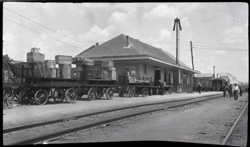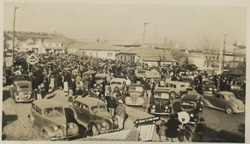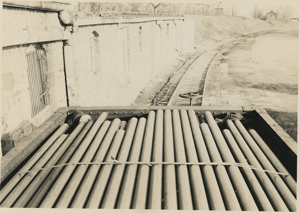When I was growing up in Henryetta, three local coal mines shipped a total of about 120 railroad cars of coal daily. As a result, the Frisco railroad had to have a lot of empty cars on had each day to take to the mines to be filled the next day. It was a continuous operation. Cars were taken to the mines to be filled and shipped away and empty cars were brought into Henryetta and placed on sidings to be taken to the mines when the earlier ones were filled.

The Frisco had some long sidings, both in town and to the north of town, to hold the waiting cars. The longest continuous siding in town was one that went from the Frisco's Fourth street crossing nearly to main street. Then another Frisco siding picked up at Trudgeon behind Boerstler Brothers grocery warehouse.
There were more further north that included cars for other industries like PPG, Ellis Glazing Plant, Decker Tools, etc. In all, Henryetta was Frisco's second highest shipping point in Oklahoma in those days, exceeded only by all the shipping from the Tulsa Refineries. Younger boys (higher grade school and junior high) liked to walk the tops of the sides of the empty cars and jump from one car to the next. Walking all the cars on the siding south of main was really a big deal. Those of us who lived near the Frisco were sometimes more daring about it than was appropriate, and while we knew that falling off could have bad results, boys just had to be boys.
I recall a day when a northbound train was stopped on the main track, with its caboose just northeast of Fourth Street. (Back in those days, freight trains had what was called a caboose as its rear car. They don't have them today.
Instead, the rear car of a freight train now has a waving white light at its rear end, and that light can be seen by another train that that is trailing or caching up with it.) Having to do the boy thing, I ran and climbed up and into the caboose, with my sisters yelling at me to come back.
When I got in, I saw that the caboose had a couple of rooms and a man was sitting at a sort of a desk. He didn't look very friendly, so I turned and left without even introducing myself. Mother heard about it from my sisters, so that ended my caboose climbing career.
Boys who lived in the south part of Henryetta had the most fun walking coal cars, primarily because boys in most of the town didn't have any to walk and boys in the east part just had a few that were north of Main by Boerstler Brothers along beside the long ago ice plant. But boys who lived east of the tracks walked those few on the way to school just because they were there to walk.
 I don't know the year, but suspect it was when I was in the 6th grade at Washington School in the spring of 1942, when two boys from east of the downtown tracks and a year or two older than me decided to walk sides of the cars by Boerstler Brothers on the way back to school after lunch.
I don't know the year, but suspect it was when I was in the 6th grade at Washington School in the spring of 1942, when two boys from east of the downtown tracks and a year or two older than me decided to walk sides of the cars by Boerstler Brothers on the way back to school after lunch. I think one was Edsel Price, who happened to have a glass eye as a result of and earlier BB gun accident. (Yes, you really can loose an eye from a BB gun.) I don't remember who the other boy was.
The car they were walking was full, or partly full, of oil pipe, apparently waiting for a train to some other destination or unloaded in Henryetta. As they reached the end of the car, they saw hands and arms mangled between the end of the pipe and the end of the car. Enough could be seen to tell they were parts of two boys.
Scared and shocked, the boys climbed off the car and ran to tell someone. I don't know if it was someone at Boerstler Brothers or the Frisco Depot, but it started the spreading of the horrible news.
The pipe was a little shorter than the length of the car and for a reason only young boys would understand, climbed down in the empty end and while they were there, the car, or the chain of cars it was in, was hit by an engine and all the pipe shifted to the end where the boys were.
Word spread quickly and since the afternoon bell hadn't yet sounded at school, many of the kids went to the area.
By climbing onto the roof of Boerstler brothers, were able to look down into the car to see the results of the disaster. But I wasn't among them.
I always walked (or ran) home for lunch, and it was a real test to bet back to school on time, so I suspect I was still on the way back.
While I usually took the shortcut from Fourth and the Frisco tracks to downtown and then up First or Second to Gentry, I guess that on that day I ran all the way on Fourth to Gentry, and then turned east to Washington School.
The immediate concerns in Henryetta were to learn who the boys were and where the tragic event had taken place.
All railroads had very good records as to where every car on its line was at all times since most of the rail cars are owned by others, such as companies that ship a lot of goods, companies whose business is to own rail cars, or other railroads, and each railroad has to pay a fair-size daily rental charge to the owner of the car for each day the car is on its line – even if parked on a siding.

All Frisco stations were connected by telegraph and by the end of the day, or at least by the next morning, the Frisco had learned that a couple of days before the particular car was in Henryetta, it had been switched from a different rail line to the Frisco at Monet, Missouri, which was a major Frisco switching point back then – it might still be. And they learned that two Monet boys had been missing for a couple of days. So they say the mystery was solved.
I don't know if the incident lowered the tendency of Henryetta boys to walk the cars. It might have, but I sort of doubt that it did. Boys are boys and their brains are still several years from developing into adult brains. I don't even recall if I stopped or continued. But one thing I remember is that I always remembered the matter, and later, when I was in the army during the Korean conflict, a troop train I was on changed rail lines at Monet, Missouri one evening and a lot of USO people gave us snacks. While there, I definitely remembered those two boys.
Publisher's note: The photos above are from the Hardin Collection from the Territorial Museum. The last photo in the series is believed to be the one of the tragedy.















